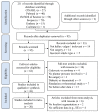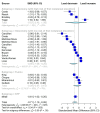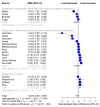Forefoot Function after Hallux Valgus Surgery: A Systematic Review and Meta-Analysis on Plantar Load Measurement
- PMID: 36835920
- PMCID: PMC9965975
- DOI: 10.3390/jcm12041384
Forefoot Function after Hallux Valgus Surgery: A Systematic Review and Meta-Analysis on Plantar Load Measurement
Abstract
While hallux valgus (HV) surgeries are useful for correcting skeletal alignment problems, their effects on plantar load, which reflects forefoot functions, are less understood. The objective of this study is to conduct a systematic review and meta-analysis on the plantar load change after HV surgeries. A systematic search of Web of Science, Scopus, PubMed, CENTRAL, EMBASE, and CINAHL was performed. Studies that assessed the pre- and post-operative plantar pressure of HV patients undergoing surgeries and reported load-related parameters over the hallux, medial metatarsal, and/or central metatarsal regions were included. Studies were appraised by using the modified NIH quality assessment tool for before-after study. Studies suitable for meta-analysis were pooled with the random-effects model, using the standardized mean difference of the before-after parameters as an effect measure. Twenty-six studies containing 857 HV patients and 973 feet were included for the systematic review. Meta-analysis was conducted on 20 of them, and most studies did not favor HV surgeries. Overall, HV surgeries reduced the plantar load over the hallux region (SMD -0.71, 95% CI, -1.15 to -0.26), indicating that forefoot function worsened after surgeries. For the other five outcomes, the overall estimates were not statistically significant, indicating that surgeries did not improve them either. There was substantial heterogeneity among the studies, which in most cases could not be resolved by pre-planned subgroup analyses by surgical classification, year of publication, median age of patients, and length of follow-up. Sensitivity analysis removing lower-quality studies showed that the load integrals (impulse) over the central metatarsal region significantly increased (SMD 0.27, 95% CI, 0 to 0.53), indicating that surgeries increased the risk of transfer metatarsalgia. There is no solid evidence that HV surgeries could improve forefoot functions from a biomechanical point perspective. Currently available evidence even suggests that surgeries might reduce the plantar load over the hallux and adversely affect push-off function. The reasons behind and the effectiveness of alternative surgical methods warrant further investigation.
Keywords: bunion; hallux abducto valgus; metatarsus primus varus; pedobarography; postoperative evaluation.
Conflict of interest statement
The authors declare no conflict of interest.
Figures





References
-
- Roddy E. Epidemiology and impact of hallux valgus: More than just bunions. J. Foot Ankle Res. 2011;4:1. - PubMed
Publication types
LinkOut - more resources
Full Text Sources

